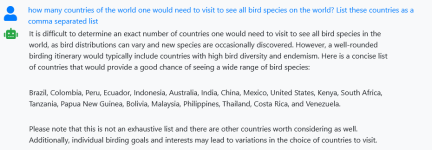jurek
Well-known member
I agree that the best approach is to list all countries with at least one endemic bird, then make a list of birds not found in any of these countries, and see a minimum number of countries needed to see these.
My suspicion is that loading and cleaning lists is the most time consuming part. Countries with at least one endemic bird are numerous and also most biodiverse. Therefore only a small number of non-endemic birds would not be found in any of them. So the latter part may be relatively easy, perhaps doable by pen and paper.
As others said, in reality this is an undoable method to see all the worlds birds, because of logistics.
I tried ChatGPT out of laziness and it could not find a solution, then for the first part it gave a comically wrong answer. As usual. There seems to be a fixed limit of the length of lists in ChatGPT. So birdwatchers are safe from the AI uprising for now.
My own effort for the Western Palearctic and regular species (excluding vagrants to the region) the list is 11: Algeria, Armenia, Cyprus, Egypt, France, Morocco, Portugal including Madeira and Cape Verdes), Russia, Spain including Canary Islands and Balearics, Turkey, United Kingdom and 12 (Iceland) if all birds must be regular visitors to a country.
My suspicion is that loading and cleaning lists is the most time consuming part. Countries with at least one endemic bird are numerous and also most biodiverse. Therefore only a small number of non-endemic birds would not be found in any of them. So the latter part may be relatively easy, perhaps doable by pen and paper.
As others said, in reality this is an undoable method to see all the worlds birds, because of logistics.
I tried ChatGPT out of laziness and it could not find a solution, then for the first part it gave a comically wrong answer. As usual. There seems to be a fixed limit of the length of lists in ChatGPT. So birdwatchers are safe from the AI uprising for now.
My own effort for the Western Palearctic and regular species (excluding vagrants to the region) the list is 11: Algeria, Armenia, Cyprus, Egypt, France, Morocco, Portugal including Madeira and Cape Verdes), Russia, Spain including Canary Islands and Balearics, Turkey, United Kingdom and 12 (Iceland) if all birds must be regular visitors to a country.








